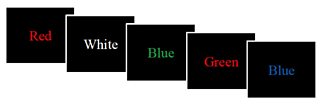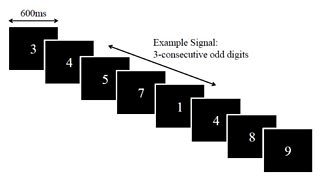The big brain boost experiment: task information
Mood
We used the Bond-Lader Visual Analogue Mood Scale (Bond & Lader, 1974). Participants completed 16 questions which provided three overall mood scores: alertness, contentedness, and calmness. Each question comprised an analogue scale with antonyms either side of the scale. Participants used the mouse to drag an arrow to the point on the scale that reflected their current state.

Stroop
The Stroop Task (Stroop, 1935) is a measure of selective attention. Participants are presented a series of colour names (red, green, white, and blue) and those colour names are either presented in a colour semantically consistent or inconsistent with the word.

Participants are required to respond to the colour in which the font is presented and ignore the meaning of the word. Participants therefore have four response keys which relate to red, blue, white, and green coloured font. They are instructed to respond as quickly and as accurately as possible.
Across the experiment participants received 144 trials (each trial is a word presented on the computer screen). Each colour name is presented in the colour consistent with word meaning on 18 trials and presented in a colour inconsistent with word meaning on 18 trials (6 trials for each of the 3 inconsistent colours). When the font colour and colour name are inconsistent, participants must inhibit the semantic information and selectively attend to the font colour.
Rapid Visual Information Processing Task
The Rapid Visual Information Processing Task is a measure of sustained attention and working memory. Participants are presented with digits (100 digits per minute) for 10-minutes.

Participants are told to attend to the digit sequence and respond (by pressing the response key) when there is a sequence of 3 consecutive odd or 3 consecutive even digits. These signals appear approximately 8 times per minute.
The task requires participants to attend to each digit and continually update working memory. This enables the participant to assess whether the preceding two digits and the current digit meet the criteria for a response.
What exactly is a portalite?
The portalite is a piece of equipment which can non-invasively measure how much blood is flowing at a particular point in our bodies. It does this by sending beams of light of a particular wavelength, βnear infraredβ, into the body. Near infrared light travels easily through tissue, skin and bone but is absorbed by one of the main components in our blood: haemoglobin (the part of the blood which carries oxygen).
The portalite shines beams of near infrared light into the body and then measures how much returns to the sensor. When less light is received, it means there is more absorption by more hemoglobin. When there is more hemoglobin, there is more blood, assuming the concentration of the hemoglobin in blood is constant during the measurement.
When a certain part of the brain gets more βactiveβ, it needs more energy. This energy will be delivered by more blood and so lots of blood suggests that part of the brain is more active.
In our experiment, five of the volunteers wore the portalite on their forehead as they carried out the afternoon tests. With the volunteers who chewed gum we saw an increase in the oxygenated haemoglobin during both tasks. This supports the theory that chewing gum could make you feel alert by increasing the blood flow to the frontal lobe of the brain.
